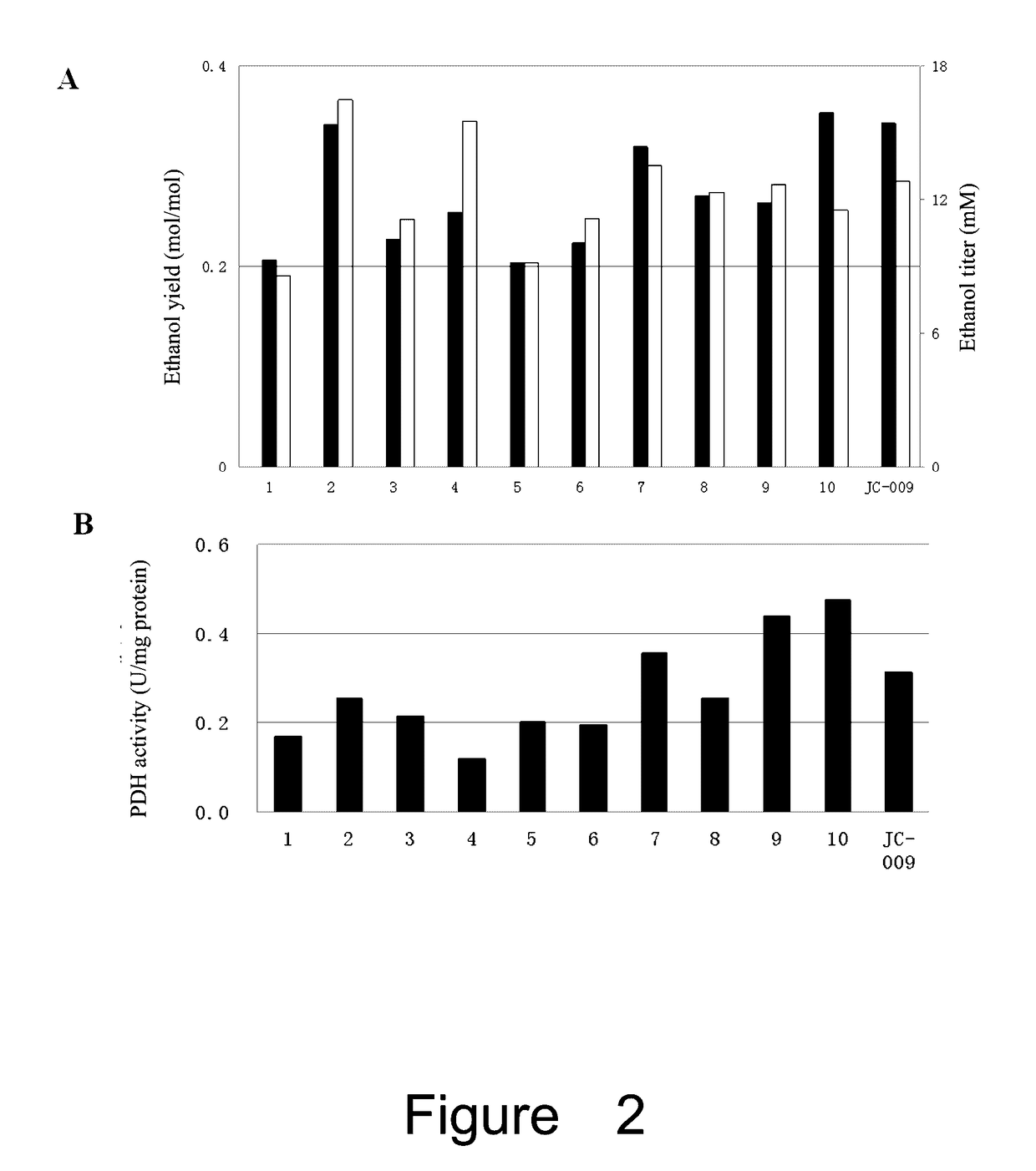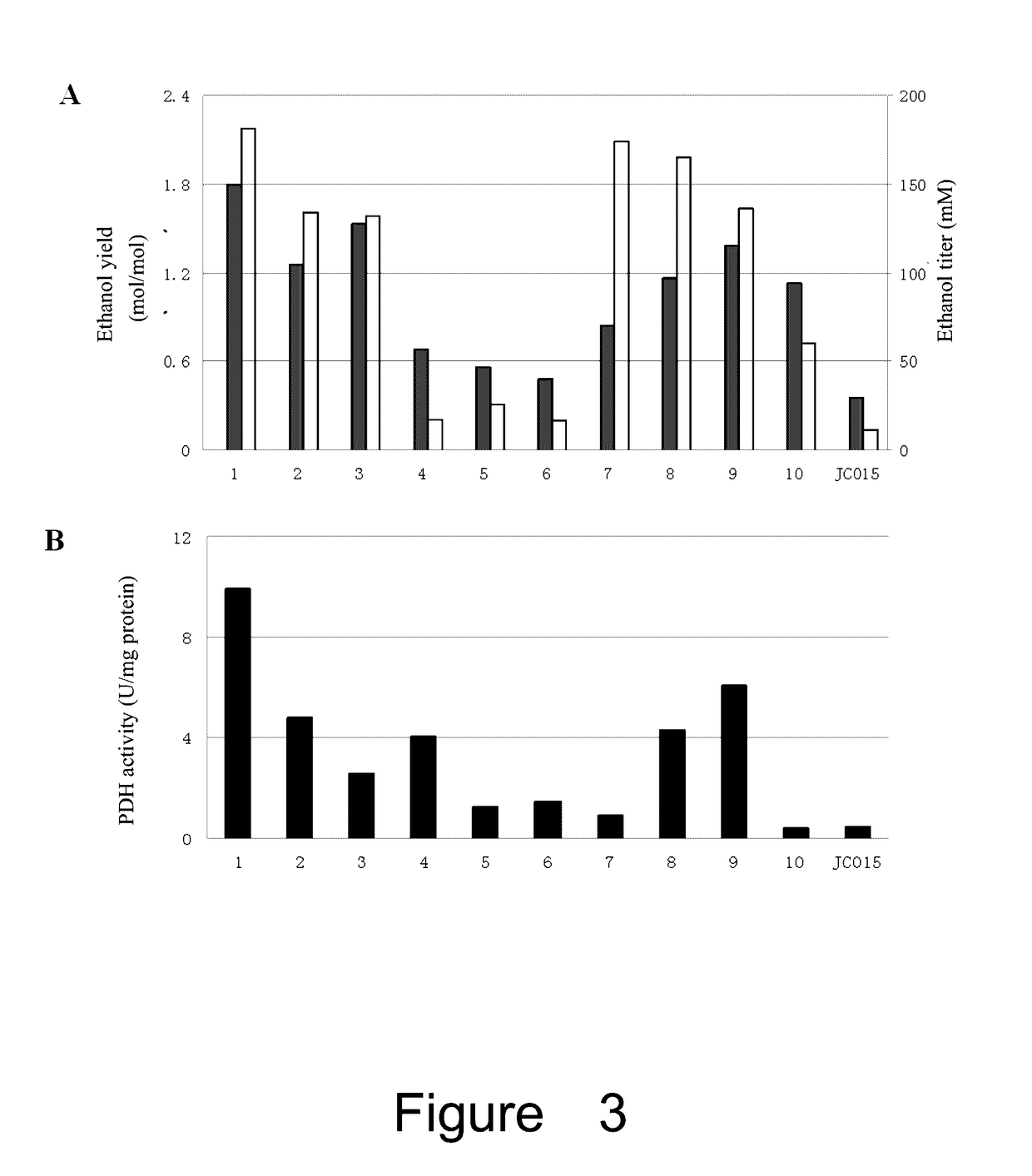Escherichia coli containing mutated lpdA gene and application thereof
a technology of escherichia coli and mutated genes, applied in the field of gene-modifying e. coli, can solve the problems of critical rate-limiting enzyme in metabolic pathways, and achieve the effects of enhanced expression and enhanced activity of said mutated lpda gen
- Summary
- Abstract
- Description
- Claims
- Application Information
AI Technical Summary
Benefits of technology
Problems solved by technology
Method used
Image
Examples
example 1
Construction of Strain HX024
[0103]E. coli ATCC 8739 was metabolically engineered for succinate production through deleting lactate dehydrogenase gene ldhA, pyruvate formate lyase gene pflB and phosphoenolpyruvate sugar phosphotransferase enzyme I gene ptsI, activating galactose MFS transporter GalP and phosphoenolpyruvate carboxykinase PCK, deleting phosphotransacetylase gene pta and acetate kinase gene ackA, and activating malate synthase AceA, isocitrate lyase AceB and dicarboxylate transporter protein DcuC, resulting in strain NZ-037.
[0104]After metabolic evolution of NZ-037 for 1080 generations, the strain HX021 was obtained.
[0105]The mgsA gene (GenBank No. ACA78263.1) was deleted from strain HX021 to obtain the recombinant E. coli HX023.
[0106]After metabolic evolution of HX023 for 360 generations, the strain HX024 was obtained. The recombinant strain HX024 was deposited at CGMCC (Institute of Microbiology of Chinese Academy of Sciences, NO. 1 Beichen West Road, Chaoyang Distric...
example 2
Cloning lpdA Gene and Mutated lpdA Gene into pTrc99A-M
[0107](1) Construction of the plasmids pXZ163 and pXZ174 (containing lpdA gene from E. coli ATCC 8739 (Gunsalus et al., 1941, J Biol Chem 141:853-858) and the strain HX024 (CGMCC 7259), respectively).
[0108]Taking the genomic DNA of E. coli ATCC 8739 and HX024 as template, amplification products were amplified using a primer set 8739-lpdA-up-SacI / 8739-lpdA-down-PstI (SEQ ID No.: 7 / SEQ ID No.: 8). The resulting PCR products were digested with SacI and PstI (NEB, UK) at 37° C. for 30 min, and the plasmid pTrc99A-M was digested with the same enzymes (Shi et al., 2013, Metab Eng 16:1-10). The digested products were cleaned using Purification Kit Cleaning Gel / PCR Extraction kit (BioMIGA Biotechnology Company). Cloning system: 50 ng of the fragment of interest and 20 ng of pTrc99A-M fragment were added with 2 μl of 10XT4 ligase buffer solution (NEB), 1 μl of T4 polynucleotide kinase (NEB), supplemented with distilled water to 20 μl of t...
example 3
Effect of the Mutated lpdA on PDH Activity and NADH Inhibition
[0116]Cell culture and induction: pre-inocula of strains containing one of the above 7 plasmids (pXZ163, pXZ165, pXZ173, pXZ178, pXZ179, pXZ180 or pXZ174) and control plasmid pTrc99A-M (empty plasmid) were grown by transferring fresh colonies into 3 ml of LB medium. After growing overnight, these cultures were diluted into 250 ml flask with 30 ml LB by an inoculum of 1% (v / v), and grown at 37° C. with shaking at 250 rpm. When OD=0.3, IPTG was added (final concentration of 1 mM) and continued to grow for 4 hours.
[0117]Preparation of crude extracts: 30 ml of the induced bacteria was collected by centrifuge at 4° C. The pellets were washed with pre-cold Tris-HCl (pH7.5) two times, and then suspended in 1.5 ml Tris-HCl (pH7.5). The cells were disrupted with Sonicator (SCIENTZ-II0, Ninbo Bcientz Biotechnology Co., Ltd, China), with an intensity of 25% for 3 min, sonicating for 1 sec and stopping for 1 sec. Finally, the disrupt...
PUM
| Property | Measurement | Unit |
|---|---|---|
| total volume | aaaaa | aaaaa |
| total volume | aaaaa | aaaaa |
| total volume | aaaaa | aaaaa |
Abstract
Description
Claims
Application Information
 Login to View More
Login to View More - R&D
- Intellectual Property
- Life Sciences
- Materials
- Tech Scout
- Unparalleled Data Quality
- Higher Quality Content
- 60% Fewer Hallucinations
Browse by: Latest US Patents, China's latest patents, Technical Efficacy Thesaurus, Application Domain, Technology Topic, Popular Technical Reports.
© 2025 PatSnap. All rights reserved.Legal|Privacy policy|Modern Slavery Act Transparency Statement|Sitemap|About US| Contact US: help@patsnap.com



